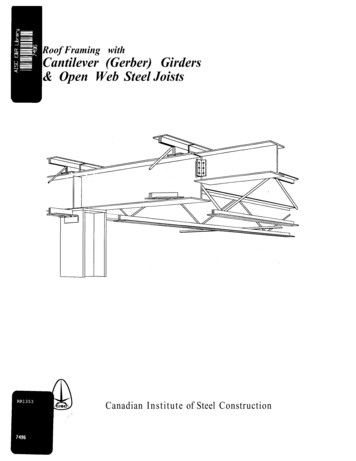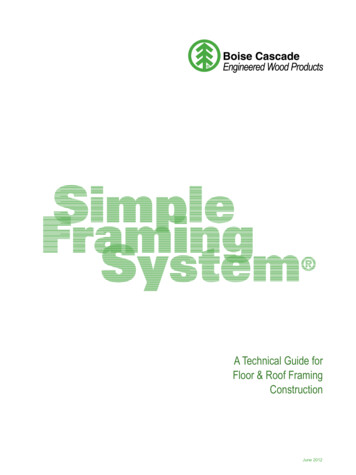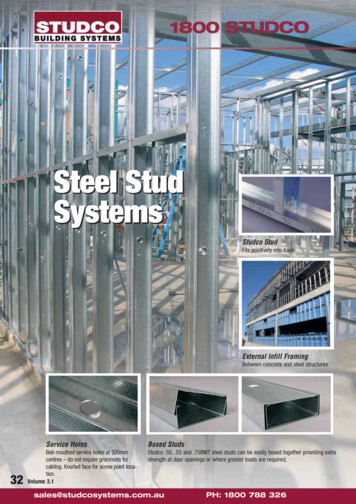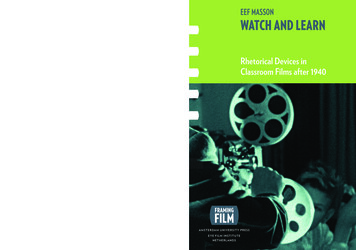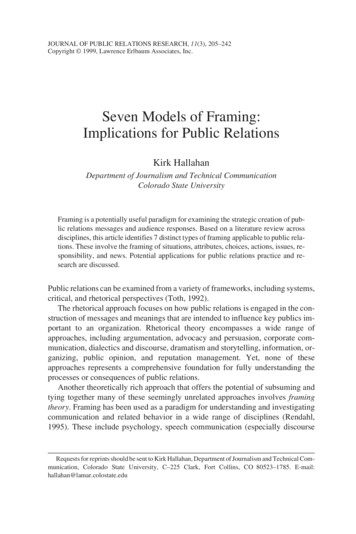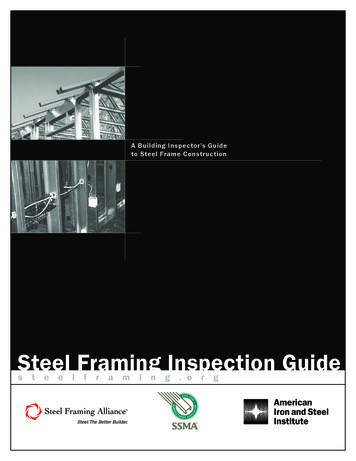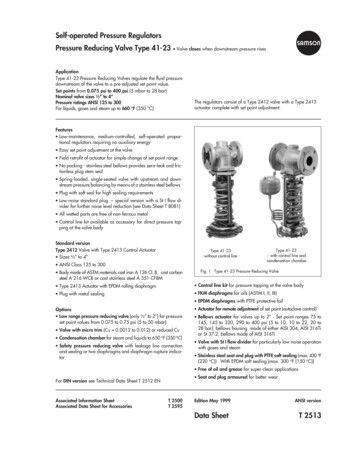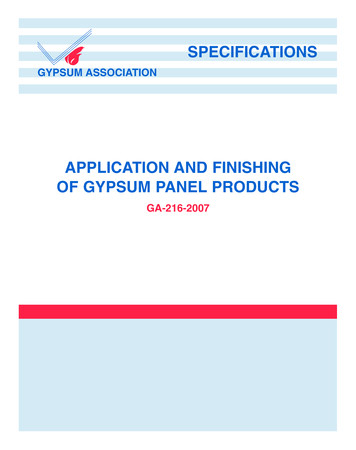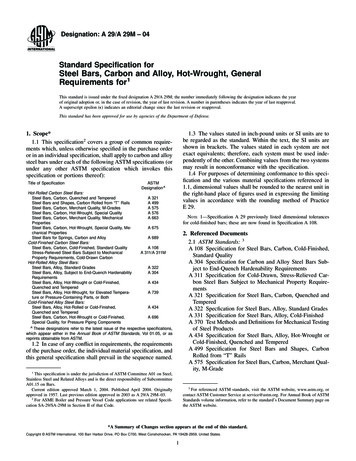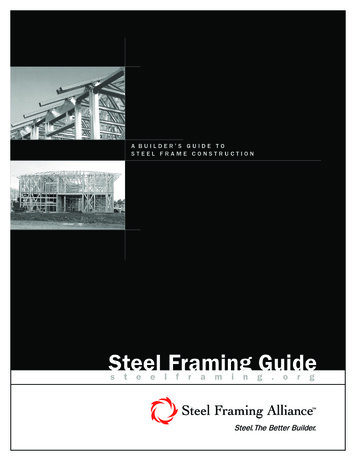
Transcription
,A BUILDER S GUIDE TOSTEEL FRAME CONSTRUCTIONSteel Framing Guides t e e l f r a m i n g . o r g
STEEL FRAMING GUIDESTEELFRAMINGGUIDEA N E A S Y- T O - U S E G U I D E F O R S T EIntroductionSteel framing is a practical, code approved solution tomany of the limitations that builders face today when usingtraditional building materials.Builder FAQ’sone1What is cold-formed steel framing?The strength and ductility of structural cold-formedCold-formed steelsteel (CFS) framing, along with the holding power of CFSframing is sheet steelconnections, make it the ideal material for constructionthat is formed intoin high wind speed and seismic zones such as the U. S.shapes and sizes thateastern seaboard, the Gulf Coast states, California andare similar to whatHawaii. Characteristics such as non-combustibility, termitebuilders are accustomedresistance, and dimensional stability can lower constructionto seeing in dimensionaland home ownership costs. CFS can provide the frameworklumber (2x4, 2x6, 2x8,for a solid sustainable building program. Each piece of CFS2x10, 2x12, and soshipped to the jobsite contains a minimum of 25% recycledforth). Steel framingcontent and is 100% recyclable at the end of its lifespan.members are formedAnd a recent study, conducted by the NAHB Research Center,in a process called rollshowed that the zinc coating on steel framing materials canforming by passingprotect against corrosion for hundreds of years.sheet steel throughFor these reasons, and many others, the use of steelframing continues to grow every year with more than 40%of commercial structures now using steel framing and withnearly 500,000 homes built with steel framing over the pastdecade.This Builder’s Guide answers the most commonly askedquestions regarding CFS and describes the fundamentalprocess for converting to steel framing. In addition,this document provides a guide to where more detaileda series of rollers toform the bends that make the shape, e.g. the web, flanges,and lips of a stud or C-shape. Because this process is donewithout heat (also called “cold forming”) the studs and joistsare made stronger than the original sheet steel.two2Why should I consider Building withcold-formed steel framing?knowledge or resources are available.Steel framing can lower construction costs. Warranty call-backs are minimized because steel does notshrink, split, or warp. As a result, there are no nail pops ordrywall cracks to fix after the structure is completed. steelframing.org
ELFRAMECONSTRUCTION Consistent quality means that scrap is drastically reduced(2% for steel versus 20% for wood). These savings alsotranslate into lower costs for jobsite culling of woodmaterials and haul off and disposal of discarded material. Discounts on builders risk insurance for steel framedstructures can result in significant cost savings for builders.Stick Framing“Stick framing” is the method most commonly used to buildwood framed homes today, and involves assembling thefloors and walls using individual studs and joists on theconstruction site. This method often requires extensivecutting of individual framing members, and requires a fairlySteel framing is easier to handle because steel studs weighhigh level of skill of framers who must know how to assemble1/3 less than wood studs, and can be installed at 24” onthe elements within the house.center.Framing and trusses represent approximately 20% of theSteel framing offers marketing advantages becausetotal cost of the house construction. If the conventional “stickconsumers recognize steel as a superior framing product forframing” method of construction is used, steel framing canits fundamental characteristics:add 3% to the total cost of a house. When only the framing Long term maintenance costs are reduced because steelsystem is considered, studies have shown that a stick-framedis resistant to rot, mold, termite and insect infestation. Good indoor air quality (IAQ) is promoted because steeldoes not emit volatile organic compounds (VOCs). Steel is “Green” because it contains a minimum of 25%recycled steel and is 100% recyclable. Steel framing has proven performance in high wind andseismic zones.The non-combustibility of steel allows a significant densityincrease in commercial and multi-family structures, offeringbuilding owners with the potential for higher revenue.3How much will cold-formed steelthreeframing cost compared to woodframing?steel system can cost 15% more than wood framing. Howeverthere are a number of savings that builders realize when theyuse steel framing1, including; Warranty callbacks associated with the seasonalmovement of framing members are virtually eliminated( 400) Save on waste haul off ( 210) Insurance savings ( 60) Site culling of wood framing ( 100)PanelizationPanelization, or assembling thecomponents of the house (walls, floors,roofs) in a controlled manufacturingenvironment, is increasingly being usedin home building today. Steel framingis particularly suited for panelizationThe method of construction, stick framing or panelization,because it is precision manufactured toand type of project will have a direct bearing on the cost ofmeet exacting tolerances, and its lightthe steel frame system.weight allows for easier handling of assembled components.Panels are typically shipped unsheathed which, whencombined with the light weight of cold-formed steel, allowsNumbers have been interpolated for a 2,800 square foot home with a sale price of 373,300 from NAHB statistics. Insurance information from a Zurich brochure 2004.1steelframing.org
STEELFRAMINGGUIDEA N E A S Y- T O - U S E G U I D E F O R S T ESTEEL FRAMING GUIDECFS fabricators to service a large distribution area. Thecapability of delivering product to a large market allowsfabricators to recognize economies of scale that keep CFSpanel costs in check.Residential Conventional ConstructionBuilders can design one- and two-story structures without thesupport of an engineer by using the American Iron and SteelInstitute’s Prescriptive Method, one of the AISI standardsreferenced by the building codes. The Prescriptive Methodprovides load and span tables, fastener requirements, etc.in a “cookbook” format similar to what is available for woodframing design. The Prescriptive Method and other designstandards can be purchased from the Online Store on theSteel Framing Alliance’s website (www.steelframing.org).Standards for Cold-Formed Steel FramingAISI StandardThe component (panels) approach will speed constructionand reduce the number of skilled framers that are requiredon site. As a result, steel framing can cost the same or lessWall Designthan wood framing in many parts of the country.Joist DesignTitleStandard forCold-Formed SteelFraming –Prescriptive Methodfor One and TwoFamily DwellingsRafter Design4How Does the Design Process Work?fourComprehensive provisions for steel framing are found in theIRC Code 2.4.5R603R505R804Header DesignStandard forCold-Formed SteelFraming – HeaderDesignR603.6Truss DesignStandard forCold-Formed SteelFraming – TrussDesignR804.1.3International Code Council’s (ICC) International Building Code(IBC) and International Residential Code (IRC), which arerecognized as the governing building codes by most buildingShould the structure go beyond simple design or thedepartments in the United States. (See Resources for the ICCapplicability limits of the Prescriptive Method, a qualifiedwebsite that provides an overview of code adoption acrossengineer will be needed to develop or complete the structuralthe United States.) The building codes also reference a seriesdesign. This is also true for certain states, like California,of Standards that have been developed by the American Ironas well as other jurisdictions, where prescriptive design steelframing.org& Steel Institute (AISI) to provideis not allowed. Fortunately, the number of professionaladditional information for theengineers who have experience with steel framing has growndesign of steel structures. (Seeexponentially over the last decade and the Cold-Formed SteelStandards for Cold-Formed SteelEngineers Institute (CFSEI) has an on-line member databaseFraming table.)(www.cfsei.org).
ELFRAMECONSTRUCTIONPre-fabricated SystemsWalls, floor panels and roof trusses of CFS that are built ina factory will require engineered drawings and layouts forbuilding code approval, just like any other pre-manufacturedstructural component. Panel and truss manufacturers aredrawings are coordinated with the structural drawings.3. Structural drawings will be reviewed for consistency withthe architectural drawings, and to ensure that specificsystem detailing for items like components and trusses,are provided.staffed to provide engineered designs, based on the builder’sProgress inspections by the building department are requiredarchitectural drawings, along with the components andat the same stages of completion as structures built with anyjobsite delivery. Some manufacturers can offer a “turn-key”other building materials.solution to builders with the inclusion of product installationThe Steel Framing Alliance (SFA) has provided training toby trained crews.Non-residential Constructionthousands of building plan reviewers and inspectors acrossthe United States. Training seminars for state and municipalbuilding departments, builders, and trades persons, as wellCommercial designs will requireas, vocational/technical school curriculum development arean engineer’s review andsome of the on-going activities sponsored by the SFA.seal regardless of material ofconstruction.5fiveHow does the Plan Check andBuilding Inspection Process Work?six6How do I Order Steel Framing?The process for ordering steel framing materials will differgreatly according to the type of construction method that willbe used.Conventional FramingOne of the first steps in implementing any project should bea conversation with the local building department. This is thebest way to uncover the particulars that relate to your projectand building code jurisdiction.Although some large builders order steel directly from thestud manufacturers, cold-formed steel is typically suppliedby a regional distributor. Steel distributors include traditionallumber yards and gypsum board supply warehouses. TheThe plan check process is similar to what is encountered forSFA’s membership includes some of the major manufacturersother structural systems:of cold-formed steel in North America which can be identified1. The reviewer will verify that all specifications are accurateand that they match local code requirements.2. Architectural drawings are checked to ensure thatwall types are correctly marked, fire-rated assemblies,if required are shown, details are provided for keythrough the Member Directory found on the SFA website(www.steelframing.org). Many manufacturers will providea link to distributors and a technical service contact ontheir website. Please visit the Steel Stud Manufacturer’sAssociation website for further information (www.ssma.com).connections, and mechanical, electrical and plumbingsteelframing.org
STEELFRAMINGGUIDEA N E A S Y- T O - U S E G U I D E F O R S T ESTEEL FRAMING GUIDEIn addition, manufacturers of proprietary products (whichTypical Wood and Steel Dimensionsoften consist of non-generic steel shapes) will work directlywith the builder to develop a framing Specifying:When ordering steel framing materials, it’s important to be2x4350S162-433 ½”1 ⅝”43aware of the variety and applications of the various shapes,2x6600S162-436”1 ⅝”43encapsulated by the acronym STUFL.2x8800S162-438”1 ⅝”43These letters stand for Stud, Track, U channel, Furring, and2 x 101000S162-4310”1 ⅝”43L-header, pictured at the bottom of the page.A stud includes wall studs, joists and rafters because theyare all of the same shape.Track is the top and bottom “plates” of a steel wall or the rimof floors and rafters.U-channel can be used for bridging, blocking and customizedfor cabinet backing.Furring channel is used as purlins, bridging, backing, and forsubassembly sound separation.L-headers are brake-metal shaped members that can bedoubled and used as headers.Cold-formed steel is specified by a universal designatorsystem called out by web dimension, shape, flange dimensionand thickness. Web and flange sizes are expressedMaterial Cut Lists:Distributors may not be staffed to develop cut lists or providequantity take offs for steel framed jobs. Details on how toraise material cut lists can be found in the SFA’s NationalTraining Curriculum and in Steel Framed House Construction,a publication of the Craftsman Book Company.Pre-fabricated System SuppliersSome builders have found that ordering factory fabricatedsteel wall panels and trusses is an ideal way to move intosteel framing because it minimizes the need for highlyskilled framers on site and provides access to experienceddesign and layout professionals. Typically, the builder simplyprovides the panel or system manufacturer with architecturalin 1/100ths of an inch and thickness is expressed indrawings and they do the rest. There are numerous CFS panel1/1000ths of an inch, or “mils”.manufacturers across the country that can be located byusing SFA’s online Member Directory (www.steelframing.org).Stud or joist steelframing.orgTrackU-channelFurring channelL-header
ELFRAMECONSTRUCTIONseven7What are the differences in Headers are built up from multiple steel members justlike with wood, or by using time saving L-headers.construction details between CFSand wood? Steel framing is usually spaced at 24” O.C. and woodframing is typically spaced at 16” O.C. Layouts proceed just as they do with wood frameconstruction. Installation is typically handled by buildinga wall section on the deck and later raising it. C section studs replace wood studs and singletracks replace top and bottom wood plates. With panelized construction many of these steps areeliminated, reducing the framing responsibility to positioning and fastening the pre-assembled components. Studs are connected to track flanges with screws, orpins, installed through the face of the track flangeinto the stud flange. Three threads or 3/8” of the screwshould be visible on the back side of the connection. In most residential applications, plywood or OSB is usedfor floor, wall and roof sheathing, just as in a woodframed house. Sheathing is attached to steel framingusing pins shot from a pneumatic gun at a cost andrate of speed similar to the tools used for woodconstruction.steelframing.org
STEEL FRAMING GUIDESTEELFRAMINGGUIDEA N E A S Y- T O - U S E G U I D E F O R S T E Backing the frame for cabinet installation requiressome customization with C-shaped stud, steel strap,track, or there are a handful of proprietary productsthat can be used.eight8How will my Trades be Affected?FramersExperienced framers will find it relatively easy to transition tosteel framing. They understand floor plans and elevations andcan covert these to floor and wall layouts. With assistanceand training, experienced carpenters adapt to CFS veryquickly. However, there is a learning curve associated with The only major differences in building with steel framingare in-line framing techniques, the tools, fasteners andaccessories used, and the need for foam insulation onthe exterior side of the wall studs in some geographicregions.new tools and fasteners.Basic steel framing tools are a screw gun (adjustable torque,0-2500 rpm), bits and bit holders for structural steel to steelconnections, chop saw, pneumatic pin nailer for steel to steelconnections and sheathing to steel connections, clamps, In addition, MEP trades will see minor differences inhow they install wiring and plumbing (see MEP Tradessection 8 for more detail).aviation snips, swivel head electric shear, and a magneticlevel.New, faster and more efficient tools are coming onto themarket all the time. Please follow the manufacturer’sspecifications for products and applications. The SteelFraming Alliance website is a good source of contactinformation for tool and fastener manufacturers. steelframing.org
ELFRAMECONSTRUCTIONScrew GunHand SeamerLocking C-clampsUse: Steel to steel and sheathing to steel fastenerseatingMax steel thickness: 97 milsCost: Corded starting at 199Specs: Adjustable clutch/torque; industrial grade;0-2500 rpm (var. speed); 5.4 amp motor;reversible with bit tip holder releaseUse: Position and bend steelMax steel thickness :n/aCost: 30Specs: 3 1/4”Use: Clamp steel members for fasteningCost: 10 - 45Specs: 6”, 9” and 11” regular tip, 2 pairAviation SnipsMagnetic LevelElectric ShearUse: Coping track flanges; cutting studs and trackMax steel thickness: 33 milsCost: Starting at 20Use: Plumb wallsMax steel thickness: n/aCost: 30 and upSpecs: 48”Use: Quick field cutsMax steel thickness: 68 mils(One per Framing Crew)Cost: Starting at 300Specs: Swivel head14” Chop SawPneumatic NailerCollated Screw GunUse: Repetitive cutting of studs, rafters, joists,track(One per Framing Crew)Max steel thickness: 97 milsCost: Starting at 200Use: Steel to steel and substrates to steelfastening(Optional)Cost: Starting at 525Specs: PneumaticUse: Gypsum board to structural steel fasteningMax steel thickness: 97 milsCost: Cordless 250Specs: Adjustable clutch/torque; industrial grade;0-4000 rpm (var. speed); 5.4 amp motor;reversible with depth locatorsteelframing.org
STEEL FRAMING GUIDESTEELFRAMINGGUIDEA N E A S Y- T O - U S E G U I D E F O R S T EMechanical / Electrical / PlumbingMEP (mechanical, electrical and plumbing) trades can beretrained rather quickly for cold-formed steel installations.For the plumber and electrician, routing wire and pipesthrough steel walls may prove simpler than what they’re usedto with wood frames, as the studs come pre-punched withholes along the stud and joist length.nine9What Fasteners will I need?The key to fastener selection with steel framing is to keep itsimple. Basically there are three head and two point styles.Hex, pan and bugle head screws will easily address almost allapplications. Hex heads are used where they won’t be covered byanother material like drywall or sheathing. Pan heads are typically used in areas where drywall orsheathing will be applied. Bugle heads are designed to countersink into the materialthey are driven into, so are ideal for installing drywall.There are two types of screw points to choose from, selfpiercing when working with thinner material (like interiordrywall studs), and self-drilling when penetrating into thethicker structural steel studs.Plastic grommets, installed by the trades, snap in placethrough the punchout openings. The grommets protect wireand PEX from the sharp steel edges or provide corrosionprotection for copper. Duct, pipe, and wire supports will befastened to the framing with screws and accessories that areHex headPan headBugle headwidely available.The allowableelectrical wiringSelf-Drilling Screw PointSelf-Piercing Screw Pointmethods referencedin Table 3701.2 ofthe InternationalResidential Codeinclude nonmetallic sheathedcable, also known as“Romex”, which can be used in steel framing. The code alsocovers grounding.10steelframing.orgThe Prescriptive Method requires that structural connectionsbe fastened using No. 8 and No. 10 screws. Generally,No. 10s are required for roof member to member connectionsand No. 8 fasteners are appropriate in other locations.Drywall can be installed with No. 6 screws. Screws for allapplications are readily available from local supply houses.
ELFRAMECONSTRUCTIONOther Types of Fastenerssuch as floors and walls, which are available from the SFA.Other cold-formed steel connection techniques exist andA formal technical training program is offered at communitymany are code approved.colleges nationwide. SFA and the Association of the WallPneumatically-driven fasteners, powder-actuated fasteners,crimping and riveting have all been developed for steel-tosteel and sheathing-to-steel connections. Review theapplication with a manufacturer’s representative and localcode officials before implementing usage of alternativefasteners.Sheathing and drywall may be attached to steel frameswith pneumatically-driven nails. These nails are specificallydesigned with spiral grooves or knurls on the nail shaft topenetrate the steel and, like automatic nail delivery in woodframing, are applied with air guns.and Ceiling Industry (AWCI) jointly developed STEEL DoingIt Right, a three-day training program given in a format thatpromotes interaction between the participants and theprofessional engineer instructors, is offered in major citiesand at builders’ events throughout the year (see www.awci.org).ResourcesThe Steel Framing Alliancehttp://www.steelframing.orgMember DirectoryDirectory of Training CentersNational Training CurriculumAssociation of the Wall and Ceiling Industryhttp://www.awci.orgSTEEL Doing It RightCold-Formed Steel Engineers Institutehttp://www.cfsei.org/index.phpLow Rise Residential Construction Detailsten10Where can I get Training?International Code ConferenceWood framers can adapt fairly easily to cold-formed steelSteel Stud Manufacturers Associationmaterial with a good set of blueprints, the right vernment/adoption.htmland some on-the-job training. The Steel Framing Alliancehas developed a National Training Curriculum and FieldInstallation Guides on the construction of various assemblies,steelframing.org11
Steel Framing AllianceSteel Stud Manufacturers Association1201 15th Street, NW, Suite 320800 Roosevelt Rd., Bldg. C, Suite 312Glen Ellyn, IL 60137T: 630.942.6592 F: 630.790.3095info@ssma.comwww.ssma.comWashington, DC 20005T: 202.785.2022 F: 202.785.3856www.steelframing.orgInformation in this publication is based on the “Prescriptive Method,” basis of the steel requirements in the International Residential Code (IRC) andInternational Building Code (IBC). Some information has been summarized from the Steel Framing Alliance’s (SFA) “National Training Curriculum.” For moreinformation or to obtain these publications, visit www.steelframing.org.The materials set forth herein are for general information only. They are not a substitute for competent professional assistance. Application of anyinformation contained in this document to a specific project or setting should be reviewed by a qualified individual. SFA believes that the informationcontained in this publication substantially represents industry practice and related scientific and technical information, but the information is not intended torepresent an official position of the SFA or to restrict or exclude any other construction or design technique. Additional design and detailing (i.e., coordinatingwith other materials, material specifications) is required for any of the details before they can be incorporated into construction documents. Anyone makinguse of the information set forth herein does so at his or her own risk and assumes any resulting liability.Steel Framing Alliance SFA, 2007. All Rights Reserved.
STEEL FRAMING GUIDE STEEL FRAMING GUIDE A N E A S Y- T O - U S E G U I D E F O R S T E E L F R A M E C O N S T R U C T I O N steelframing.org Introduction Steel framing is a practical, code approved solution to ma
